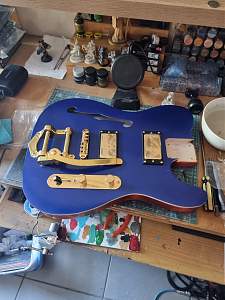Having completed the setup of hardware on the body I shifted to the neck, proceeded with a thorough clean and oil before drilling out the holes for the tunners. This was the first issue, should have drilled from both sides of the head stock instead of one pass down, broken splinters on the raw side means filling and gluing. The next issue was fitting the tunners, proceed to start pre drilling the holes for the screw at the back went alright, but fitting the nut on the front was a different matter. Alot of them where really tight to start off, backing out and trying again only had the same effect, forcing one on I snapped the nut right off the shaft. So have to wait till the new tunners show up before strings, nut and other fine tunning begins.






 Reply With Quote
Reply With Quote



